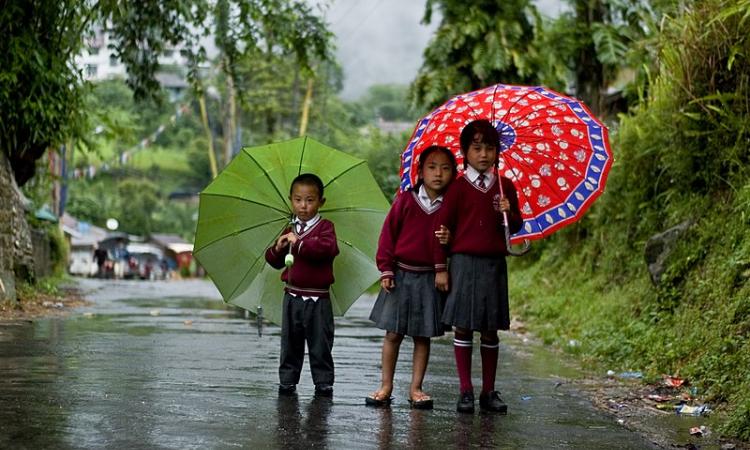
Skies in several parts of Kerala are overcast with pre-monsoon but monsoon is progressing sluggishly, as per meteorological predictions. “This year’s monsoon rains will arrive on India southern coast in Kerala on June 4 and deliver less rain than average year,” says Skymet, a private weather forecasting agency. The shadow of El Niño, a global ocean phenomenon marked by the warming of the equatorial Pacific Ocean, will affect the onset of the monsoon. The report suggests that El Niño is likely to continue during the monsoon season. El Nino indicates below normal rains that can hurt our farm-dependent economy.
“The onset of monsoon will be three days late around June 4, the error margin being two days. It seems that the initial advancement of monsoon over peninsular India is going to be slow. The sluggish progress is not a promising situation. The onset and further progress are also not expected to be very smooth,” says Jatin Singh, managing director of Skymet. The southwest monsoon rains, which brings in over 70 percent of the country’s rain and supports kharif, the key agriculture season is expected to retreat from Rajasthan by September.
In a recent forecast, the India Meteorological Department (IMD) had predicted a monsoon onset date of June 6 along the Kerala coast. Earlier in April, the IMD had forecast average rainfall over the June-September monsoon season. As per IMD’s definition, average (or normal) rainfall stands for between 96 percent and 104 percent of a 50-year average of 89 centimetres for the period of June to September. The IMD will provide a long-range forecast of the overall rainfall in the first week of June.
In sharp contrast to IMD’s projections, Skymet had in its earlier forecast in April predicted below normal rains in the four-month period. All forecasts point to extended summer heat in India. June is set to be drier. Temperatures have shot up above 45°C in May in some parts of the central and western India. Any delay in monsoon rains could bring in less than normal rainfall in June, a crucial time for sowing kharif crops. The region-wise forecast for this year’s monsoon by Skymet indicates that rains would be poorer than normal over central India, east and northeastern states. Monsoons would be better in north-west India and parts of the south.
The Weather Company, a private weather forecaster has projected a very high (80 percent) probability of below-normal rainfall in June in Kerala, coastal Karnataka, Konkan, Goa, Gujarat, Madhya Pradesh, Uttar Pradesh, Bihar, Jharkhand, West Bengal and Odisha. The active (wet) phase of the onset-facilitating Madden-Julian Oscillation (MJO) wave would re-emerge over the Indian Ocean, as per the weather forecast. The MJO wave is a global band of lower pressure, convection (cloud-building) and rainfall travelling from west to east periodically. This has implications for weather over the region it passes. If MJO re-enters the Indian Ocean with enough strength, it can push the monsoons to reach Kerala faster. As of now, the MJO is in a suppressed (dry) phase and chances are that it will further delay the arrival of monsoon.
The Climate Forecast System model predicts the rapid eastward circulation of a moderate MJO wave during the week of May 22 to 28, and this is expected to decelerate over the West Indian Ocean during the next week. As per the IMD’s own coupled operational model for extended range forecast, MJO wave would steadily weaken from May 24 and would reactivate during June 1 to 4, but weaken again into the second week of June. There is also the possibility that a tropical system would develop over the Arabian Sea and may affect the monsoon onset.
As per Skymet’s forecast, the country is expected to receive 93 percent rainfall of the long period average (LPA) in 2019. Central India, which grows cotton, maize and soybean is likely to receive 91 percent rainfall of the LPA, while the eastern and northeastern part of the country is likely to get 92 percent rainfall of the LPA. The rice-growing southern peninsula is likely to get 95 percent rainfall, while rice and wheat growing northwest India may get 96 percent rainfall.
Rains are considered normal when they are between 96 percent and 104 percent of the LPA.
The geographical risk remains high for Bihar, Jharkhand and West Bengal, while it is marginal for Northeast India. Hilly states of Jammu and Kashmir, Himachal Pradesh and Uttarakhand are likely to perform better than the plains of Punjab, Haryana, Rajasthan and Delhi-NCR. Odisha and Chhattisgarh are likely to be the rainiest of all, while Vidarbha, Marathwada, west Madhya Pradesh and Gujarat will be poorer than normal. North Interior Karnataka and Rayalaseema may see poor rainfall. Kerala and Coastal Karnataka are likely to perform better.
/articles/monsoon-arrive-late-less-rain-expected-skymet